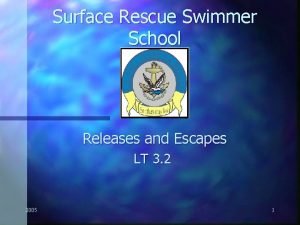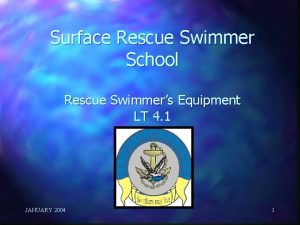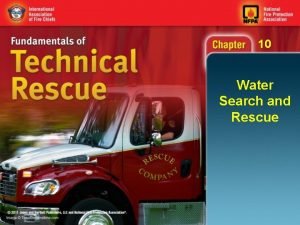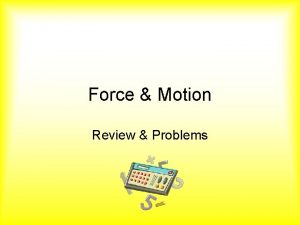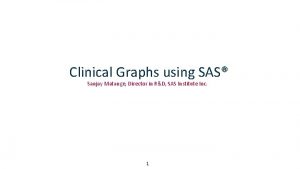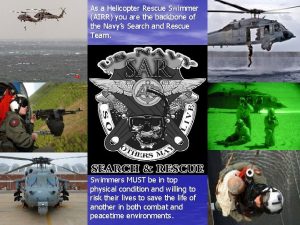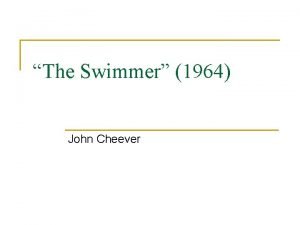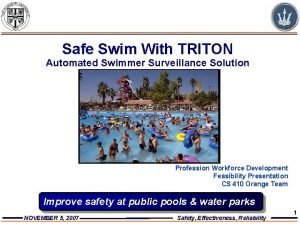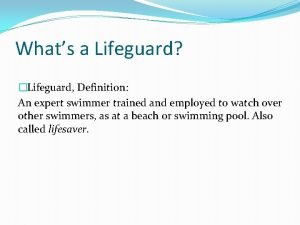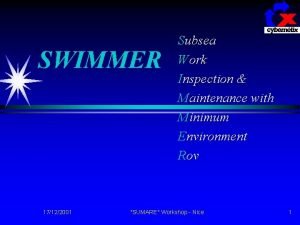Rescue Swimmer School Surface Rescue Swimmer School OverviewCourse
















- Slides: 16

Rescue Swimmer School: Surface Rescue Swimmer School Overview/Course Introduction LT 1. 1 2005 1

Enabling Objectives Cite OPNAVIST 3130. 6 and NWP 350. 1 series requirements for RSS training. n Explain all safety precautions used during RSS training. n State the remedial training policy. n State the DOR/TTO policies and procedures. n 2005 2

Course Overview Applicability: The Rescue Swimmer Course is designed for individuals who have not previously graduated from Rescue Swimmer School and are reporting to a rescue swimmer billet. 2005 3

Course Overview (cont. ) Goals: This course provides students with initial training and hands-on experience in first aid, CPR, rescue equipment, life saving techniques, day/night water entries, parachute disentanglement, search and rescue tactics, night and multiple rescue situation. Students will undergo physical training consisting of calisthenics, swimming, and running. 2005 4

Course Overview (cont. ) NAVAL WARFARE PUBLICATION 3 -50. 1 The NWP 3 -50. 1 is the Naval Search and Rescue manual. It promotes and maintains standardization of SAR procedures, equipment, and techniques. Course content is mandated by this manual and should be used in conjunction with the Trainee Guide. 2005 5

Course Overview (cont. ) Evaluations: Academic exams to test knowledge. n Practical exams to demonstrate correct rescue swimmer procedures. n Graded physical training events to verify effective conditioning. n 2005 6

Course Overview (cont. ) Extra Instruction and Remediation: n Extra Instruction (EI) - Designed to assist students having difficulty attaining course objectives. - In comparison to standard instruction, EI consists of a lower student-to-instructor ratio and is taught at the pace of the slowest student. - Students are strongly encouraged to seek EI. Instructors may also assign EI. 2005 7

Course Overview (cont. ) Extra Instruction and Remediation: n Remediation: - Assigned to students in response to failure of a criterion test; preparation for re-test. - Same instructional characteristics as EI. 2005 8

DROP ON REQUEST/ TRAINING TIME OUT POLICY: Drop on Request (DOR) Policy: In all cases where a student states a desire to DOR from voluntary training based on concern for personal well-being, appropriate action shall be initiated, including removal from training, referral of the student for medical, counseling or remedial action as appropriate, and review of the training environment, including training techniques. The scope and depth of these actions shall be determined by the nature of the complaint and the risk incurred in the training. A written summary of actions taken shall be made a permanent entry to the student’s service record. In no case shall a student be coerced or threatened to induce him or her to return to training following a DOR. 2005 9

DROP ON REQUEST/ TRAINING TIME OUT POLICY A Training Time Out (TTO) may be called by any student or instructor in any training situation where they are concerned for their own or another’s safety, or they request clarification of it, procedures or requirements. TTO is also an appropriate means for a student to obtain relief if he or she is experiencing pain, hear stress, or other serious physical discomfort. The purpose of the TTO is to correct the situation of concern, provide clarifying information , or remove the student or instructor from the possible hazardous environment……… 2005 10

DROP ON REQUEST/ TRAINING TIME OUT POLICY …. . A TTO may be signaled with the abbreviation TTO, the words Training Time Out, crossed hands in a (T), a raised clenched fist, or other specific signals which will be briefed prior to a specific lab, test, or exercise. If the TTO signal is not acknowledged, the signaler shall shout “Time Out” (or other action as required by the training activity). The instructor shall attempt to relieve and remove the student from the possible hazardous environment. If an adequate number of instructors are available to allow training to continue safely, the lead instructor may elect to do so. However, if this is not practical, training will be stopped until the situation is corrected. 2005 11

Course Overview (cont. ) ADMININSTRATIVE PROCEDURES AND REGULATIONS: n n Pre-requisite screens - Purpose of pre-requisite screens - Students screening forms - Medical Up-chits Students will complete instructor, course, and quality of life critiques. Security precautions for personal valuables. Following participation in rescue swimmer training, entries shall be made in the appropriate training jacket. 2005 12

Course Overview (cont. ) SAFETY PRECAUTIONS: n n Hazardous conditions may exist in the training environment; students have a responsibility to report any unsafe/unhealthy condition they may discover. In the event of an in-water emergency, signaled by multiple whistle blast or sounding of applicable alarm. Students will exit the pool immediately and proceed to the predestinated location and follow the directions of staff. 2005 13

Course Overview (cont. ) n n MISHAP/NEAR-MISS/ UNSAFE CONDITION REPORTING PROCEDURES: A mishap is any unplanned or unexpected event causing personnel injury, occupational illness, death, material loss or damage, or an explosion of any kind whether damage occurs or not. A hazardous condition is any situation which, if allowed to go unchecked or uncorrected, has the potential to cause a mishap. 2005 14

Course Overview (cont. ) MISHAP/NEAR-MISS/ UNSAFE CONDITION REPORTING PROCEDURES: n n A near-miss is when a mishap is avoided merely by chance. It is the responsibility of all Department of Defense personnel to report all mishaps, near-misses, and any unsafe or unhealthy (hazardous) condition (s). If a mishap, hazardous condition or near-miss occurs the student shall inform the instructor immediately. OPNAV 5100/11 with instructions is available formal reporting. 2005 15

Summary n Can a student request Extra Instruction (EI)? n Yes, EI is encouraged if a student is having difficulty learning course objectives. n Saying “I quit” will result in removal from training. True or False? n True, the student would be treated as a DOR and referred to the Division Officer. 2005 16
 Surface rescue swimmer school
Surface rescue swimmer school Surface rescue swimmer school
Surface rescue swimmer school Rescue swimmer wetsuit
Rescue swimmer wetsuit Objectives of search and rescue team
Objectives of search and rescue team Total surface area for triangular prism
Total surface area for triangular prism Spin coat
Spin coat Curved surface area and total surface area of cone
Curved surface area and total surface area of cone Question tag introduction
Question tag introduction A swimmer has dropped her goggles
A swimmer has dropped her goggles Ap 219
Ap 219 Speed a way
Speed a way Swimmer plot
Swimmer plot Swimmer detection
Swimmer detection Competitive swimmers diet plan
Competitive swimmers diet plan Lawn allow drawing swimmer
Lawn allow drawing swimmer Ingrid is a good swimmer. she ____ swim for hours
Ingrid is a good swimmer. she ____ swim for hours Arad=v^2/r
Arad=v^2/r

